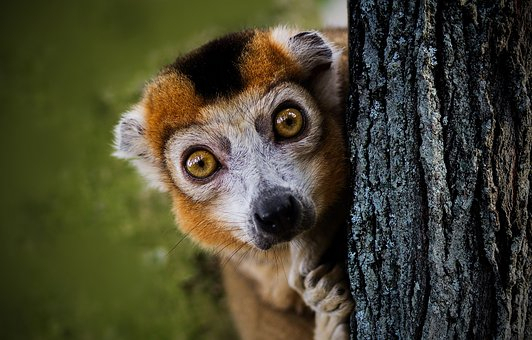
Many primates have specific characteristics that may be strange to humans but are extremely essential for these animals. These traits help them in day to day functioning as well as survival.
Such are hands of Aye-aye or Daubentonia madagascariensis -- house cat-size lemurs native to Madagascar—with super-long, spindly third and fourth fingers used to tap on trees to find grubs. One of nature's more absurd creations, these mammals "have strange hands and bizarre fingers", said Adam Hartstone-Rose, who specializes in the study of muscles of forearms.
Hartstone-Rose, who does not study only human forearms but also of many primates and compares anatomical differences between species in his lab at North Carolina State University, said the omnivores with an average life span of 20 years in the wild gnaw into the bark with rodent-like incisors and remove the goods with their chopstick-like digits.
Their brains, the largest of any lemur relative to body mass, allow them to find the larvae's tunnels, explained Hartstone-Rose and colleagues, who traced the route of a muscle called the abductor pollicis longus down into the forearm of the species.
"This is one that in humans extends the thumb away from the body, a motion called abduction. It allows you to hitchhike," he said, adding the part of the muscle in aye-aye splits off and connects with a bone called the radial sesamoid, which is usually small in other primates but elongated in this endangered species.
The team in a study published in the American Journal of Physical Anthropology suggested two other muscles were connected to the radial sesamoid, which allows the bone to move in a gripping motion.
Calling it "pseudo-thumb", which functions as the sixth digit to help the arboreal animals hold onto tree limbs, Hartstone-Rose said this kind of anatomy was found for the first time in a primate as weird as an aye-aye.
He added that such studies of arm and hand anatomy, and the differences between lineages, could help better understand how these structures had evolved in different species, including humans.
The team hypothesizes that aye-aye throughout evolution lost some ability to grip due to the extreme specialization of its other fingers, while its fourth finger accounted for more than two-thirds the length of its hand, adding that it would be nearly a foot long if humans had such a digit.
Its third digit, which is primarily used for tapping, is very thin and has a wide range of motion, equipped with a unique ball-and-socket joint, the team explained and added the species may have evolved this pseudo-thumb to help it stay aloft, and perhaps even to pick up different items or foods.
Giant pandas also have a pseudo thumb, a similar scenario like aye-aye, whose ancestors have digits in a single line, allowing them to walk on the ground.
Panda bears however evolved to feed upon bamboo even though they needed to eat more than 12 hours each day to digest it.
He said the process was an example of convergent evolution by which very distantly related species had similar bodily structures.
Dorothy Fragaszy, a primatologist and a National Geographic explorer and an emeritus professor at the University of Georgia, said those little nub "clearly allow them to press or rub the [pseudo-thumb] bony projection against things they're holding in their palm.









